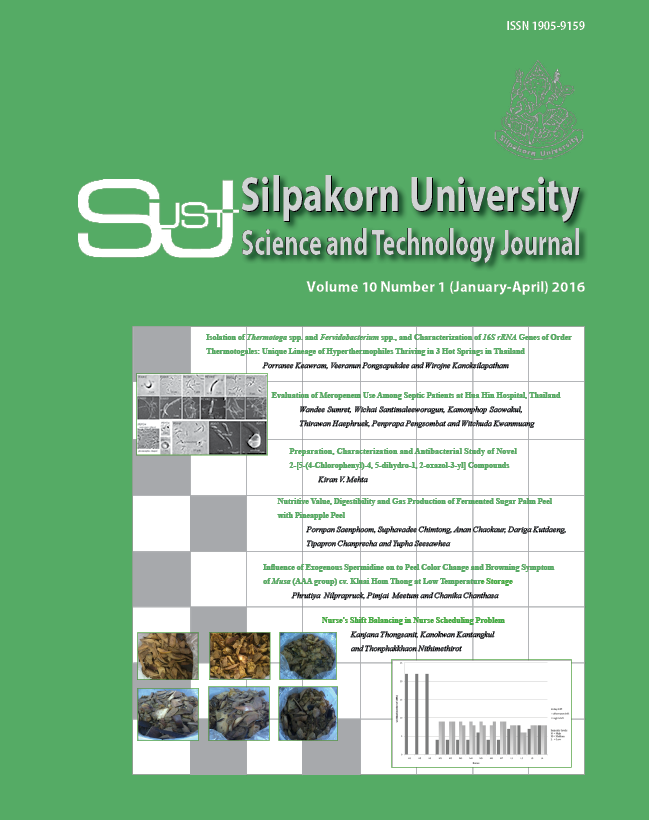Evaluation of Meropenem Use Among Septic Patients at Hua Hin Hospital, Thailand
Main Article Content
Abstract
Antimicrobial-resistant bacteria are an important medical concern. This problem might be resulted from an inappropriate use of antibiotics. The review of antibiotic drug use could help understanding the cause of drug resistance and eventually resolve the problem. Our retrospective cohort study aimed to review meropenem use at Hua-hin hospital, Prachuap Khiri Khan, including therapeutic indications, dosage regimens and duration of sepsis treatment. Data were gathered from patients admitted in the hospital during January to December 2013. The sources of data included patient medical records, patient database from computer program and in-house form of meropenem evaluation. A total of thirty-six cases were evaluated, 17 cases (47.2%) were male, and the average age was 58.3 (±19.9) years. There were 22 cases (61.1%) and 14 cases (38.9%) receiving meropenem as empirical and definitive therapy, respectively. According to meropenem use evaluation, there were 29 (80.6%), 33 (91.7%) and 24 (85.7%) cases that met the criteria for indication, dosage regimen, and treatment duration, respectively. Only 17 cases (60.7%; n=28) met all three criteria for appropriate meropenem use. Thus, with our finding, the role of healthcare professionals in reducing the inappropriate use of antibiotics for the entire course of treatment should be encouraged.
Downloads
Article Details
References
Balode, A., Punda-Polic, V., and Dowzicky, M. J. (2013). Antimicrobial susceptibility of gram-negative and gram-positive bacteria collected from countries in Eastern Europe: results from the Tigecycline Evaluation and Surveillance Trial (T.E.S.T.) 2004-2010. International Journal of Antimicrobial Agents, 41(6): 527-535.
Baldwin, C. M., Lyseng-Williamson, K. A., and Keam, S. J. (2008). Meropenem: a review of its use in the treatment of serious bacterial infections. Drugs, 68(6): 803-838.
Calandra, T., and Cohen, J. (2005). The international sepsis forum consensus conference on definitions of infection in the intensive care unit. Critical Care Medicine, 33(7): 1538-1548.
de Naurois, J., Novitzky-Basso, I., Gill, M. J., Marti, F. M., Cullen, M. H., and Roila, F. (2010). Management of febrile neutropenia: ESMO clinical practice guidelines. Annals of Oncology, 21 Suppl 5, v252-256.
Dejsirilert, S., Tiengrim, S., Sawanpanyalert, P., Aswapokee, N., and Malathum,K. (2009). Antimicrobial resistance of Acinetobacter baumannii: six years of National Antimicrobial Resistance Surveillance Thailand (NARST) surveillance. Journal of the Medical Association of Thailand, 92 Suppl 4, S34-45.
Deris, Z. Z., Harun, A., Shafei, M. N., Rahman, R. A., and Johari, M. R. (2009). Outcomes and appropriateness of management of nosocomial Acinetobacter bloodstream infections at a teaching hospital in northeastern Malaysia. The Southeast Asian Journal of Tropical Medicine and Public Health, 40(1): 140-147.
Falagas, M. E., Kasiakou, S. K., Rafailidis, P. I., Zouglakis, G., and Morfou, P. (2006). Comparison of mortality of patients with Acinetobacter baumannii bacteraemia receiving appropriate and inappropriate empirical therapy. Journal of Antimicrobial Chemotherapy, 57(6): 1251-1254
Ikeda, Y., Mamiya, T., Nishiyama, H., Narusawa, S., Koseki, T., Mouri, A., and Nabeshima, T. (2012). A permission system for carbapenem use reduced incidence of drug-resistant bacteria and cost of antimicrobials at a general hospital in Japan. Nagoya Journal of Medical Science, 74(1-2): 93-104.
Lautenbach, E., Synnestvedt, M., Weiner, M. G., Bilker, W. B., Vo, L., Schein, J., and Kim, M. (2010). Imipenem resistance in Pseudomonas aeruginosa: emergence, epidemiology, and impact on clinical and economic outcomes. Infection Control and Hospital Epidemiology, 31(1): 47-53
Lemos, E. V., de la Hoz, F. P., Alvis, N., Einarson, T. R., Quevedo, E., Castaneda, C., Leon, Y., Amado, C., Canon, O., and Kawai, K. (2014). Impact of carbapenem resistance on clinical and economic outcomes among patients with Acinetobacter baumannii infection in Colombia. Clinical Microbiology and Infection, 20(2): 174-180.
Levy, M. M., Fink, M. P., Marshall, J. C., Abraham, E., Angus, D., Cook, D., Cohen, J., Opal, S. M., Vincent, J. L., and Ramsay, G. (2003). 2001 SCCM/ESICM/ACCP/ATS/SIS International Sepsis Definitions Conference. Critical Care Medicine, 31(4): 1250-1256
Masterton, R.G. (2011). Antibiotic de-escalation. Critical Care Clinics, 27(1): 149-162.
Molton, J. S., Tambyah, P. A., Ang, B. S., Ling, M. L., and Fisher, D.A. (2013). The global spread of healthcare-associated multidrug-resistant bacteria: a perspective from Asia. Clinical Infectious Diseases, 56(9): 1310-1318.
Mouton, J. W., and van den Anker, J. N. (1995). Meropenem clinical pharmacokinetics. Clinical Pharmacokinetics, 28(4): 275-286.
Nadzam, D. M. (1991), Development of medication-use indicators by the Joint Commission on Accreditation of Healthcare Organizations. American Journal of Hospital Pharmacy, 48(9): 1925-1930.
Oxman, D. A., Adams, C. D., Deluke, G., Philbrook, L., Ireland, P., Mitani, A., Panizales, C., Frendl, G., and Rogers, S. O. (2014). improving antibiotic de-escalation in suspected ventilator-associated pneumonia: an observational study with a pharmacist-driven intervention. Journal of Pharmacy Practic. March 19, 2014, doi:10.1177/0897190014527316.
Rattanaumpawan, P., Sutha, P., and Thamlikitkul, V. (2010). Effectiveness of drug use evaluation and antibiotic authorization on patients’ clinical outcomes, antibiotic consumption, and antibiotic expenditures. American Journal of Infection Control, 38(1): 38-43.
Rimrang, B., Chanawong, A., Lulitanond, A., Wilailuckana, C., Charoensri, N., Sribenjalux, P., Phumsrikaew, W., Wonglakorn, L., Kerdsin, A., and Chetchotisakd, P. (2012). Emergence of NDM-1- and IMP-14a-producing Enterobacteriaceae in Thailand. Journal of Antimicrobial Chemotherapy, 67(11): 2626-2630.
Santimaleeworagun, W., Wongpoowarak, P., Chayakul, P., Pattharachayakul, S., Tansakul, P., and Garey, K. W. (2011). Clinical outcomes of patients infected with carbapenem-resistant Acinetobacter baumannii treated with single or combination antibiotic therapy. Journal of the Medical Association of Thailand, 94(7): 863-870.
Sirinavin, S., Suvanakoot, P., Sathapatayavongs, B., and Malatham, K. (1998). Effect of antibiotic order form guiding rational use of expensive drugs on cost containment. Southeast Asian Journal of Tropical Medicine and Public Health, 29(3): 636-642.
Sumitsawan, J., Samerkum, K., Sumitsawan, T., and Kongthong, A. (2012). Evaluation of meropenem for sepsis management. Buddhachinaraj Medical Journal, 29(1): 9.
World Health Organization. (2003). Introduction to drug utilization research, World Health Organization, Oslo.

